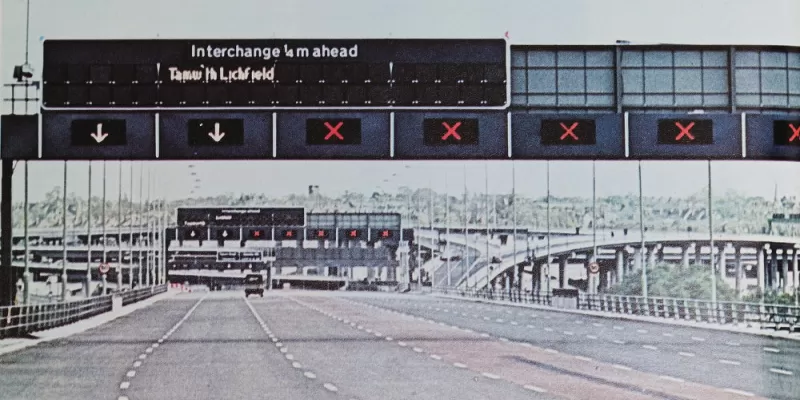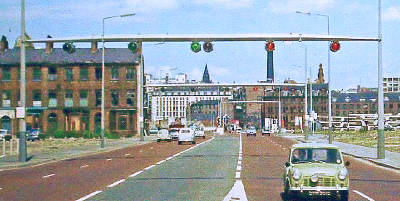While the headlines were still full of fog worries, and the Ministry of Transport was mainly preoccupied with emergency warning signs on motorways, local authorities were tasked with keeping the traffic moving on urban roads. By 1966 some of them were starting to ask themselves whether changeable signs might offer new ways to manage traffic flows.
Changeable signs for urban traffic control were not exactly new, of course: the alternate days "no waiting" signs were an early example, but automated signs had also been tried. In April 1964, a tidal flow scheme was introduced on Albert Bridge Road in West London, where automatic signs could change the road to operate either one-way or two-way depending on the time of day and the volume of traffic. There, large signs at junctions along the road, and small signs at various points along the way, took the form of boxes with a window at the front, inside which the various signs were installed on a roller blind. Motors would then scroll the blinds up or down to show the right sign. The scheme lasted, with more or less the same technology, until about 1990.
The Albert Bridge tidal flow scheme, with rollerblind "one way" signs visible on each side
Rollerblinds were a fairly primitive technology, and many of the schemes invented in the late 1960s and 1970s — even by local authorities — were much more adventurous.
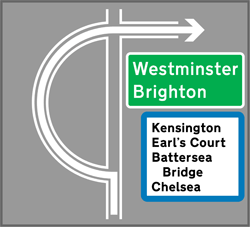
Two experiments took place in London involving cold cathode technology, which amounted to the use of fluorescent lighting tubes in various forms. The Royal Borough of Kensington made a start in 1966, looking for ways to improve the junction of Holland Park Avenue (then still the A40) and Addison Road, where a large volume of traffic turned right. They wanted right-turners to go left into Royal Crescent and then cross over Holland Park Avenue into Addison Road, to avoid forming a queue of right-turners in the middle of the road, but they only wanted this to happen during the day, so that the Crescent would be quiet again in the evenings and at night. The direction signs, therefore, had to change at different times of day.
The Borough's engineer came up with a large flat-panel direction sign that used cold cathode tubes. When the tube was lit, the sign face in front of it appeared white; when it was off, the sign face appeared grey. One of two tubes was lit to indicate one of two paths through the junction. These gained Ministry of Transport approval and were installed in January 1967, but they were not a great success. In May 1967 a delegation from the Greater London Council and the Ministry produced this disappointed report:
"When a portion of the symbol was illuminated it was very difficult to distinguish it from the unlighted portion in the average daylight. The symbol was intended to be white but in spite of the white tubes and white trough the appearance of the symbol when illuminated was a muddy grey colour. The contrast was not outstanding against the grey background of the sign panel.
"The signs had been in service for four months and there was a possibility that the luminance of the cold cathode tubes had dropped during the first 100 hours of their life."
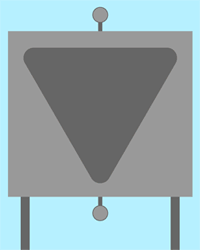
The GLC themselves conducted a different experiment with cold cathode tubes. Hyde Park Corner was, at this time, already operating as a large roundabout, but its approaches were uncontrolled, and it suffered from circulating traffic slowing to let vehicles enter. The GLC wanted to make entering traffic wait some of the time, without actually stopping them from entering if there was nothing coming. Their proposed solution was for a part-time Give Way sign.
Two large 1.2 metre (48 inch) Give Way signs were manufactured on vast metal casings, with amber flashing lights mounted top and bottom, and installed on Grosvenor Place. Some of the time they would be lit, requiring drivers to give way to traffic on the roundabout and therefore keeping the roundabout moving; the rest of the time they would be switched off and the Give Way sign would be completely invisible, allowing traffic to enter the roundabout in whatever fashion was best.
These experimental signs got a site visit too, and they appeared to be technically successful but badly placed:
"The visibility of the signs was clear from a distance of about 500 yards but not conspicuous… The driver's response was not very good as the siting of the signs was too far back from the edge of the roundabout carriageway.
"When the first two vehicles in each of the three or four lines of vehicles proceeding to enter the roundabout had stopped to ‘Give Way' to traffic in the roundabout they were already past the signs and could not see whether they were operating or not…. There were no lane lines in Grosvenor Place nor edge of roundabout carriageway markings, this did cause drivers uncertainty about where to obey the Give Way rule."
Ultimately this was a short-lived experiment, because part-time Give Way signs don't have many advantages over a normal Give Way line. But there were still plenty of other ideas to try out.
Lights, Camera, Aston
In 1969, Birmingham City Council did a very unusual thing. They started work building an entirely new kind of road: a motorway with seven lanes and no central barrier, where the number of lanes in either direction was variable. Tidal flow systems had been operated before, of course — including on Albert Bridge Road, as we saw earlier — but this was a new road, built from scratch, and it was a motorway. They would light up signs over each lane, with arrows or crosses to indicate which were open and closed, and monitor traffic flow with CCTV. That was nothing new. But they also included something much more adventurous in their control system: fibre optic direction signs.
Designs were first drawn up in 1968 for a system of direction signs in which letters and words would be picked out by points of light, which would look like a modern matrix display used on motorways today — but in this system, fibre optics would link the dots making up each individual word to a single lamp. This meant that the signs had a fixed number of words and alternatives hard-wired into them, and switching on or off a particular word or message could be done by switching a single light source on or off.
Even though this made the signs considerably simpler to operate than a modern matrix sign — in which each pixel is switched individually so that the options for displaying messages are virtually limitless — the signs still required computer control, and specialised equipment was ordered in 1971 to operate them.
There were two reasons to go for an unusual system like this: the first was that, approaching the complex junctions at either end of the expressway, drivers had to get in different lanes for different destinations, but with the number of lanes varying between two and four, the choice of lane would depend on the time of day. Changeable direction signs could show different destinations above different lanes as required. The other reason was to divert traffic away from the expressway if there was an accident or blockage: with no hard shoulder and no central reservation, Birmingham's highway planners feared that accidents would be harder to deal with and perhaps more severe than on other motorways. If something happened, they wanted a system that could advise drivers to go another way.
Testing of the new system started to take place before the road opened in 1972, and there is at least one photograph in existence showing the dot matrix destinations being tested on the approach to Spaghetti Junction. Ministry of Transport engineers reported that drivers seemed to have no difficulty in recognising the new displays as direction signs, even though they were not white-on-blue like normal signs, but while the idea was clever the actual implementation was a little bit disappointing. The text was not terribly easy to read and, once again, the aspirations of highway engineers seemed to be a couple of steps ahead of the technology.
It's not clear whether the Aston Expressway actually opened with its fancy signs in operation, but it's clear that they didn't last long, and they were replaced with normal, static motorway signs. The tidal flow system certainly remained switched off until 1987. The need to change the destination over each lane turned out not to be so important after all.
Rather crude
In Manchester, a different sort of tidal flow scheme was in operation, designed to make efficient use of a newly widened road into the city that had five lanes. The A34 Upper Brook Street was fitted with familiar overhead arrows and crosses to open and close lanes, and they were mounted on "lightweight gantries" slung across the road between the streetlights.
In August 1972 a prototype "secret sign" was demonstrated by Forest City, a major manufacturer of road signs and equipment based in Manchester, who were assisting Manchester City Council in providing better signs to explain the tidal flow system to drivers. They were using something that had been dismissed a few years before as unreliable: mechanically operated louvres.
The original designs had a series of horizontal louvres with the sign face screen-printed onto them and which were normally edge-on to passing traffic, like window blinds that had been opened to let the light in. When operated, motors rotated them to display the sign face, and when they were fully rotated, they would connect a circuit that brought fluorescent tubes on, so the sign was backlit.
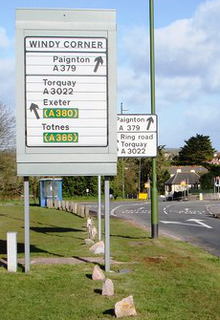
The observer from the Ministry of Transport said that "although in many ways the sign shown was rather crude it did effectively demonstrate the principle involved", and recommended that the edges of the louvres should be cut at an angle so that bands of light were not visible between them. He also noted that, because they were mounted horizontally, they soon started to sag. It was also unfortunate that, when they weren't in use, the new signs looked rather messy: behind the glass front were horizontal bars, and behind those, unlit lighting tubes and wiring.
But perhaps the most important thing was that the motors and the mechanical parts of the sign were reliable and didn't, as was once feared, cause problems with operation.
Today, these signs are everywhere — and, for many years, were probably the most ubiquitous type of variable message sign. We know them as prism signs. Rather than flat louvres, sign faces are mounted on triangular prisms, which rotate to show different messages or a blank sign face. This takes away the problems of sagging and showing the mechanism of the sign when it's not in use. It also gives more flexibility: with three sides to each prism, there can be three messages, or two messages and a blank face.
Commonly they are used in city centres for parking information, with the three messages showing "Full", "Nearly Full" or "Spaces" for each main car park. They can also be used for diversion routes or part-time restrictions, with a blank face on display when the signs aren't needed.
They even make an appearance on motorways, in the form of changeable panels in direction signs, such as those on the M40 that are capable of directing through traffic to pass either east or west of Birmingham depending on the traffic situation. And they're still on the rise: the largest rotating prism sign in the UK was installed over the A1(M) at Dishforth in 2004, and has a sign face 18.5 metres wide and 4.6 metres high. Prisms are big business.
Picture credits
- Photograph of the A38(M) Aston Expressway by Steven Jukes and used with permission.
- Photograph of Brook Street tidal flow system adapted from an original by Ben Brooksbank and used under this Creative Commons licence.
- Photograph of rotating prism sign near Brixham adapted from an original by Tom Jolliffe and used under this Creative Commons licence.

